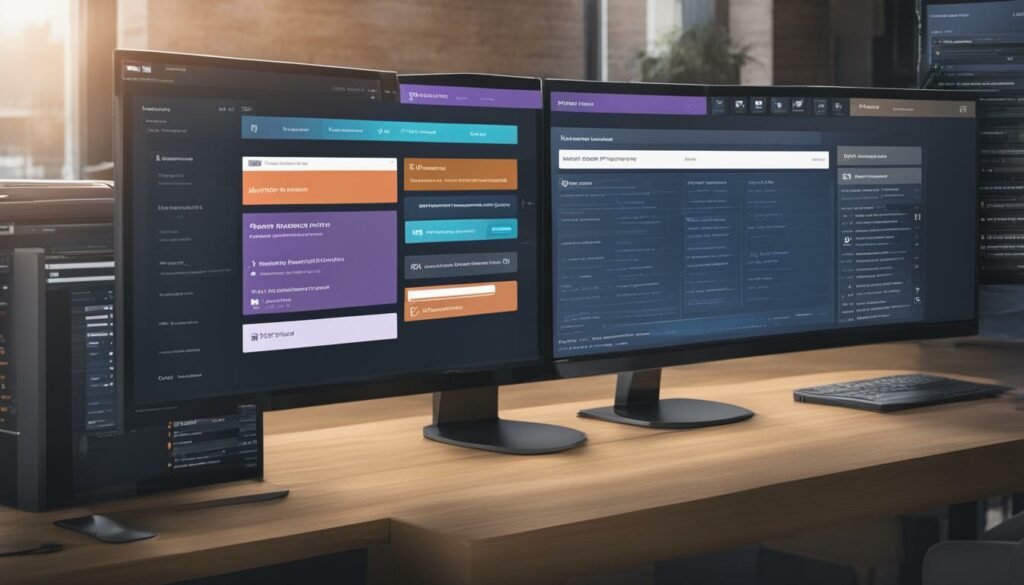Welcome to our quick start guide on creating reliable backups for your WordPress site. Whether you are a seasoned developer or new to WordPress, having a backup strategy is essential to protect your website data from security threats and human errors. In this guide, we will walk you through different methods of backing up your WordPress site, including using plugins, manual backups, and more. Let’s get started!
Key Takeaways:
- Backing up your WordPress site is crucial for data protection and website security.
- There are various methods for backing up your WordPress site, including using plugins or manual processes such as cPanel or FTP.
- The Duplicator plugin is a recommended choice for automated backups and easy restoration.
- Regular backup schedules, storing backups in secure locations, and following best practices are essential for reliable backups.
- By creating reliable backups, you can ensure the smooth operation of your WordPress site and have peace of mind.
The Importance of WordPress Backups
Backing up your WordPress site is crucial for protecting your website data. By creating regular backups, you can safeguard your files, folders, and databases from security threats and human errors that may lead to data loss.
There are various security threats that can pose a risk to your website’s data. Hackers, malware, and phishing attacks are common online dangers that can compromise your site’s security. Additionally, conflicts between plugins and themes can cause data corruption or loss. Server failures and technical glitches can also result in significant data disruptions.
By implementing WordPress backup solutions, you can mitigate the risks associated with these security threats and human errors. Regular backups ensure that you have a copy of your website data that can be easily restored in case of any issues or lost information.
“To lose your website data without having a backup is like losing the keys to your house without any spare copies.”
Whether you run a personal blog, an e-commerce website, or a corporate platform, protecting your online presence is vital. Losing valuable data can result in significant setbacks, damage your reputation, and lead to financial losses. By creating WordPress backups, you gain peace of mind and protect your investment in your digital presence.
Next, we will explore the different methods for backing up your WordPress site, ranging from automated plugins to manual processes using industry-standard tools such as cPanel and FTP.
Methods for Backing Up Your WordPress Site
When it comes to safeguarding your precious website data, there are multiple methods available for backing up your WordPress site. Each method offers its own advantages, allowing you to choose the one that best suits your needs.
1. Backup Using a Plugin
One of the easiest and most popular methods for WordPress backup is using a plugin. The Duplicator plugin is highly recommended for its user-friendly interface and automated backup capabilities. With just a few clicks, you can create backups of your entire site, including files, folders, and databases. The plugin also allows you to schedule regular backups, ensuring that your data is always up to date and protected.
2. Manual Backup
If you prefer a hands-on approach, you can opt for manual backups using either cPanel or FTP. With cPanel, you can compress and download your website files, as well as manually backup specific databases using the phpMyAdmin tool. Similarly, using an FTP client like FileZilla, you can connect to your site, navigate to the root directory, and download all the files and folders to your local storage.
3. cPanel Backup
cPanel provides a built-in backup feature that allows you to create full backups of your website. You can choose to backup your entire account, including your website files, databases, email accounts, and more. This method offers a comprehensive backup solution, ensuring all aspects of your website are protected.
4. FTP Backup
FTP (File Transfer Protocol) is another manual backup method that involves using an FTP client to transfer your website files to your local computer. You can easily download all the files and folders, creating a local backup copy. This method is useful if you want to have direct control over your backups and prefer to store them offline.
Regardless of the method you choose, it’s crucial to regularly backup your WordPress site to protect against potential data loss. By implementing a reliable backup strategy, you can have peace of mind knowing that your website data is safe and secure.
Backup Your WordPress Site Using a Plugin
When it comes to backing up your WordPress site, using a reliable plugin can save you time and ensure the safety of your data. One such plugin is the Duplicator plugin, which comes highly recommended for its user-friendly interface and robust features.
The Duplicator plugin offers a range of benefits, making it an ideal choice for your backup needs. With automated backups, you can schedule regular backup sessions without hassle. This feature ensures that your website’s data is always up to date and protected from potential risks.
Additionally, the plugin provides recovery points, allowing you to easily revert to a previous version of your site if needed. This means that even if an unexpected issue arises, you can quickly restore your website to a stable state.
Cloud storage integration is another valuable feature offered by the Duplicator plugin. You can seamlessly connect your backup files to popular cloud storage platforms, such as Google Drive or Dropbox. This integration enables you to store your backups securely in the cloud, freeing up valuable space on your local storage.
Furthermore, the Duplicator plugin includes migration tools, which can come in handy if you plan to move your WordPress site to a different hosting provider or domain. With this feature, you can effortlessly transfer your entire site, including all files, folders, and databases, to a new location.
Creating a backup using the Duplicator plugin is a straightforward process. After installing and activating the plugin on your WordPress site, you can customize your backup options to suit your preferences. Once configured, you can initiate the backup process with a simple click, and the plugin will generate a comprehensive backup of your entire site.
Once the backup is complete, you can download the backup files to your preferred storage location for safekeeping. This ensures that your valuable website data is always within reach, even in the event of a catastrophic event.
Using the Duplicator plugin for backing up your WordPress site offers automated backups, scheduled backups, cloud storage integration, and migration tools. With these features at your disposal, you can rest assured that your website is well-protected and that you have a reliable backup solution in place.

Key Features of the Duplicator Plugin
| Features | Description |
|---|---|
| Automated Backups | Schedule regular backup sessions without manual intervention. |
| Recovery Points | Easily revert to a previous version of your site if needed. |
| Cloud Storage Integration | Connect backup files to popular cloud storage platforms. |
| Migration Tools | Effortlessly transfer your site to a new hosting provider or domain. |
Manually Backup Your WordPress Site Using cPanel
If you prefer a manual approach to backing up your WordPress site, you can utilize the cPanel provided by your hosting provider. This method allows you to have full control over the backup process and gives you the flexibility to choose which files and databases to include in your backup.
Step 1: Compressing Your Website Files
To start, access your cPanel and navigate to the File Manager. Locate the public_html folder, which contains your WordPress website files. Select all the files and folders within this directory by clicking the “Select All” option.

Once you have selected the files, click on the “Compress” option from the top menu. Choose the compression format that suits your preference, such as Zip or Tar. This compression process will combine all your website files into a single compressed file, making it easier to download and store.
Step 2: Downloading Your Compressed Backup
After the compression process is complete, you can download the compressed backup file to your local computer. Simply right-click on the compressed file and select the “Download” option. Depending on the size of your website, this download process may take some time.
Step 3: Backing Up Your WordPress Databases
In addition to your website files, it’s essential to backup your WordPress databases, which store important data such as posts, pages, comments, and user information.
To back up your databases, return to your cPanel home and locate the phpMyAdmin tool. Open phpMyAdmin and select the database associated with your WordPress site. Click on the “Export” tab located at the top menu.
In the export options, you can choose to export all tables or select specific tables you want to include in your backup. Select the desired options and hit the “Go” button. This will initiate the export process, generating an SQL file containing the database structure and data.
Download the SQL file to your local computer by saving it in a secure location.
Summary
In this manual backup process using cPanel, you first compress your website files and download them to your local computer. Then, you use the phpMyAdmin tool to export your WordPress databases and save them as SQL files. By following these steps, you can ensure the safety of your website files and essential data.
Manually Backup Your WordPress Site Using FTP
If you prefer a more hands-on approach to backing up your WordPress site, you can manually backup using FTP. By using an FTP client like FileZilla, you can connect to your site and directly access your website’s files and folders.
Here’s how you can backup your WordPress site using FTP:
- Step 1: Obtain your FTP credentials from your hosting provider. These credentials usually consist of a hostname, username, and password.
- Step 2: Download and install an FTP client like FileZilla on your computer.
- Step 3: Launch FileZilla and enter your FTP credentials to establish a connection with your website.
- Step 4: Once connected, navigate to your website’s root directory. Usually, this is the public_html or www folder.
- Step 5: Select all the files and folders in the root directory and download them to your local storage. This may take some time, especially if you have a large website with many files.
By following these steps, you can create a manual backup of your WordPress site using FTP. Keep in mind that this method requires technical knowledge and may be time-consuming for larger websites.
Manual backups using FTP are an effective way to backup your WordPress site’s files and ensure that you have a local storage backup. However, it’s important to note that this method only backs up your website’s files and folders, not the entire WordPress installation or the associated databases. For a more comprehensive backup that includes your databases, consider using a plugin or other backup methods mentioned in this guide.
Remember, having reliable backups is essential for safeguarding your website data and ensuring you can restore your site in case of any issues or data loss.
Restoring Your WordPress Site from Backup
In case of any issues or data loss, you can easily restore your WordPress site from a backup. Whether you encounter a technical glitch, a security breach, or accidentally delete important files, having a reliable backup ensures that you can get your website up and running again with minimal downtime. In this section, we’ll explore the restoration process, both using the popular Duplicator plugin and manually.
Restoration with Duplicator
If you have previously created backups using the Duplicator plugin, restoring your WordPress site is a straightforward process. Here’s how you can do it:
- Login to your WordPress dashboard.
- Navigate to the “Duplicator” menu on the left-hand side.
- Select the package (backup file) you want to restore from the available list.
- Click on the “Restore” button.
- Follow the prompts and instructions provided by the Duplicator plugin to complete the restoration process.
Once the restoration process is complete, your website will be restored to the state captured in the backup file. Remember to test your site thoroughly to ensure everything is functioning as expected.
Manual Restoration Process
If you prefer a manual restoration process or don’t have access to a backup created with Duplicator, you can still restore your WordPress site using manual methods. Here are the general steps:
- Access your website hosting control panel, such as cPanel.
- Locate the file manager tool or an FTP client like FileZilla.
- Navigate to the directory where your WordPress installation is stored.
- Upload the backup files, including the WordPress files and database backup.
- Extract the files if they are compressed using a tool provided by your hosting control panel or an FTP client.
- Restore the WordPress database backup using the database management tool provided by your hosting control panel. This typically involves importing the database backup file (in SQL format).
Once the files are uploaded and the database is restored, you may need to update the necessary configuration files or settings, such as the database connection details, to ensure your website functions correctly.
Remember to consult your hosting provider’s documentation or seek assistance from their support team if you encounter any issues during the manual restoration process.

| Restoration Method | Pros | Cons |
|---|---|---|
| Duplicator Plugin |
|
|
| Manual Restoration |
|
|
WordPress Backup Plugins
When it comes to backing up your WordPress site, there are several reliable plugins available that offer a range of features and capabilities. Whether you’re looking for automated backups, customizable options, or easy restoration processes, these plugins have got you covered. Here are some of the best WordPress backup plugins to consider:
1. UpdraftPlus
UpdraftPlus is a popular backup plugin that allows you to schedule automated backups of your WordPress site. With a user-friendly interface, you can easily customize backup settings, choose where to store your backups (such as cloud storage services like Dropbox or Google Drive), and restore your site with just a few clicks. Its comprehensive features make it one of the top choices among WordPress users.
2. BlogVault
BlogVault offers a robust backup and security solution for your WordPress site. With automatic daily backups, one-click restoration, and seamless migration, you can ensure the safety of your website data at all times. In addition to backups, BlogVault also provides malware scanning and website management features, making it a comprehensive plugin for site owners.
3. BackupBuddy
BackupBuddy is a feature-rich backup plugin that offers both manual and automated backup options. You can schedule backups, store them in remote locations, and restore your site easily using the plugin’s intuitive interface. BackupBuddy also provides additional functionalities like website migration and malware scanning, making it a versatile choice for WordPress users.
4. Jetpack VaultPress Backup
Jetpack VaultPress Backup, developed by Automattic, the team behind WordPress.com, is a powerful backup and security plugin. It offers real-time backups, automated file and database scanning, and easy restoration options. In addition, Jetpack VaultPress Backup includes advanced security features like spam protection and brute force attack prevention, enhancing the overall safety of your WordPress site.
These plugins are just a few examples of the best WordPress backup plugins available, each with its own unique strengths. Depending on your specific needs and preferences, you can choose the plugin that best suits your requirements. Remember, regular backups are essential for protecting your website data and ensuring peace of mind!
Best Practices for WordPress Backups
When it comes to WordPress backups, following best practices is key to ensuring the safety and reliability of your backup files. By implementing these practices, you can protect your website data and put your mind at ease knowing that you have a secure backup plan in place.
Create a Regular Backup Schedule
Regular backups are essential for maintaining the integrity of your website data. Set up a consistent backup schedule to ensure that you always have an up-to-date copy of your files, folders, and databases. This will help you recover your website quickly if any issues arise.
Store Backups in Secure Cloud Storage
Cloud storage provides a safe and convenient option for storing your backups. By utilizing reputable cloud storage services, you can protect your backup files from local hardware failures, theft, or other physical damage. Choose a secure cloud storage provider that offers encryption and other security measures to safeguard your data.
Implement Additional Security Measures
While backups are vital, securing your backup files is equally important. Consider implementing additional security measures such as password protection, encryption, and access restrictions to ensure that only authorized personnel can access your backups. This will help prevent unauthorized access and keep your data safe.
Keep in mind that your backup files contain sensitive information, so it’s crucial to treat them with the same level of security as your live website.
Test Your Backups
Regularly testing your backups is a crucial part of the backup process. By verifying that your backups can be successfully restored, you can have confidence in their reliability. Schedule routine tests to ensure that your backup files are intact and can be easily restored if needed.
Document Your Backup Process
Documenting your backup process is essential for maintaining consistency and efficiency. Keep a record of the steps involved in creating backups, as well as any specific settings or configurations. Having clear documentation will help you streamline the backup process and ensure that no crucial steps are missed.
| Best Practices | Benefits |
|---|---|
| Create a regular backup schedule | Ensures up-to-date backup files |
| Store backups in secure cloud storage | Protects against physical damage |
| Implement additional security measures | Prevents unauthorized access |
| Test your backups | Ensures backup file reliability |
| Document your backup process | Streamlines backup procedures |
By following these best practices, you can establish a robust backup strategy for your WordPress site. Remember, backups are your safety net, providing peace of mind and ensuring that your valuable data remains secure.
Summary
Backing up your WordPress site is essential for protecting your data and ensuring the smooth operation of your website. There are several reliable backup methods available, but one recommended option is using the Duplicator plugin. This plugin simplifies the backup process and provides you with secure and reliable backup files.
By following best practices and regularly updating your backups, you can stay protected against potential security threats and human errors. Let’s take a closer look at the benefits of using the Duplicator plugin and why it’s a great choice for backing up your WordPress site.
The Duplicator Plugin: A Reliable Backup Solution
The Duplicator plugin is a powerful tool for creating automated backups of your WordPress site. It offers a range of features that make the backup process simple and efficient.
- Easy Setup: The Duplicator plugin is user-friendly and can be easily installed and activated on your WordPress site.
- Scheduled Backups: With the plugin, you can schedule automatic backups at regular intervals, ensuring your data is always up to date.
- Customizable Options: Duplicator allows you to customize your backup settings, choosing which files and databases to include in your backups.
- Migration Tools: The plugin also offers migration tools, making it easy to move your WordPress site to a new server or domain.
- Cloud Storage Integration: Duplicator integrates with popular cloud storage services like Dropbox and Google Drive, allowing you to securely store your backups off-site.
Using the Duplicator plugin for your WordPress backups gives you peace of mind knowing that your data is protected and easily recoverable in case of any issues.
Follow Best Practices for Reliable Backups
While using a plugin like Duplicator simplifies the backup process, it’s important to follow best practices to ensure the reliability of your backup files. Here are a few key practices to keep in mind:
- Create a Regular Backup Schedule: Set up a consistent backup schedule to ensure your data is regularly backed up. Weekly or daily backups are recommended.
- Store Backups in Secure Locations: Choose a secure storage location for your backups, such as an external hard drive or cloud storage service, to protect them from loss or damage.
- Test and Verify Backups: Regularly test your backups by restoring them to a test environment to ensure they are complete and functional.
- Implement Additional Security Measures: Add extra layers of security to your backup files, such as encrypting them or setting up password protection.
By following these best practices and using the Duplicator plugin, you can ensure that your WordPress site is well-protected and that you have reliable backup files to rely on.
| Benefits of Using Duplicator Plugin for WordPress Backups | Best Practices for Reliable WordPress Backups |
|---|---|
| 1. Easy setup 2. Scheduled backups 3. Customizable options 4. Migration tools 5. Cloud storage integration |
1. Create a regular backup schedule 2. Store backups in secure locations 3. Test and verify backups 4. Implement additional security measures |
Conclusion
Creating reliable backups for your WordPress site is of utmost importance when it comes to protecting your valuable data and ensuring peace of mind. By utilizing the methods and best practices outlined in this guide, you can easily backup and restore your website, safeguarding it from potential security threats and human errors.
Having a backup solution in place provides you with the assurance that even in the event of a crisis, your website can be restored quickly and efficiently. Whether you choose to use a plugin like Duplicator for automated backups or prefer manual backup methods using cPanel or FTP, the key is to establish a routine and regularly update your backups to stay prepared for any unforeseen events.
By implementing a proper backup strategy, you not only protect your data from hackers, malware, and server failures but also have the ability to recover your website in case of conflicts between plugins and themes or accidental content deletion. This allows you to focus on what matters most – growing your business and providing an optimal user experience to your visitors.
Remember, data protection is not something to be taken lightly. The peace of mind that comes with knowing your website is securely backed up cannot be underestimated. Take the necessary steps today to safeguard your WordPress site and ensure its continued success.
FAQ
Q: Why is backing up my WordPress site important?
A: Backing up your WordPress site is important for protecting your website data from security threats and human errors. It ensures you have a copy of your important files, folders, and databases, allowing you to easily restore your website in case of any issues.
Q: What are the different methods for backing up my WordPress site?
A: You can use a plugin like Duplicator for easy and automated backups, manually backup your site using cPanel or FTP, or backup specific databases.
Q: Which plugin is recommended for backing up my WordPress site?
A: The Duplicator plugin is recommended for backing up your WordPress site. It offers features such as scheduled backups, recovery points, cloud storage integration, and migration tools.
Q: How do I manually backup my WordPress site using cPanel?
A: You can manually backup your WordPress site using the cPanel of your hosting provider. This involves compressing your website files and downloading them to your local computer. You can also manually backup your WordPress databases using the cPanel’s phpMyAdmin tool.
Q: How do I manually backup my WordPress site using FTP?
A: You can manually backup your WordPress site using an FTP client like FileZilla. This method involves connecting to your site using FTP credentials, navigating to your website’s root directory, and downloading all the files and folders to your local storage.
Q: How do I restore my WordPress site from a backup?
A: In case of any issues or data loss, you can easily restore your WordPress site from a backup. Using the Duplicator plugin, you can follow the restore process and select the backup file you want to restore. The plugin will guide you through the process, and once completed, your website will be back up and running.
Q: What are some popular WordPress backup plugins?
A: Some popular WordPress backup plugins include UpdraftPlus, BlogVault, BackupBuddy, and Jetpack VaultPress Backup. These plugins offer automated backups, customizable backup options, and easy restoration processes.
Q: What are the best practices for WordPress backups?
A: To ensure the safety and reliability of your backup files, it is important to create a regular backup schedule, store backups in secure locations such as cloud storage, and implement additional security measures to protect your backup files.
Q: Why should I backup my WordPress site?
A: Backing up your WordPress site is essential for protecting your data and ensuring the smooth operation of your website. It provides a safety net in case of any security threats, human errors, or unforeseen events that may lead to data loss.
Q: How can I create reliable backups for my WordPress site?
A: By following the methods and best practices mentioned in this guide, such as using plugins like Duplicator and regularly updating your backups, you can easily create reliable backups for your WordPress site and protect your data.












